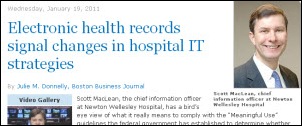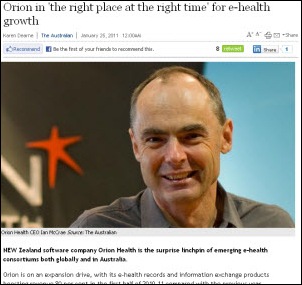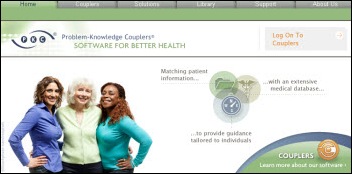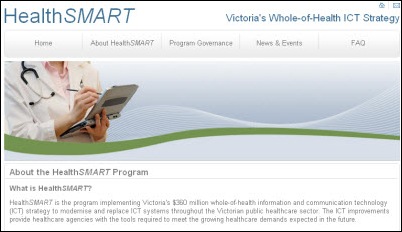"A valid concern..." Oh please. Everyone picks the software they like and the origin of that software is an afterthought.…
News 1/26/11
From Mandrake: “Re: HITECH. I heard from someone that [vendor name omitted] is writing into their hospital contracts that if the hospital gets stimulus money, the vendor receives 10% of it. I thought these dollars were for hospitals, doctors, and patients, not IT vendors. I hope this is wrong, because it definitely isn’t right.” I e-mailed the vendor in question, which has not replied so far.
From Bobby Orr: “Re: HIMSS. Not only for vendors. Here’s an interview with a community hospital CIO who’s also a HIMSS board member.” Mass High Tech interviews Scott MacLean, CIO at Newton Wellesley Hospital (MA). It’s part of the Partners system, but he says neither his administration nor his docs view IT as anything more than a support function.
From QPFC: “Re: Epic. On Glassdoor.com, ex-employees have some very interesting things to say about Epic. Judy only gets a 58% rating.” Those things are fun to read, but most of the posters have a company axe to grind (and 140 comments out of an always-churning several thousand employees isn’t a large sample). A common thread is that the new grads Judy hires resent the work hours, the not particularly talented middle management, the obsolete technologies used there, and the fact that they leave Epic unqualified to work anywhere else. It might be worrisome that turnover is mentioned often, not a good thing when experienced Epic resources are hard to find and they keep selling more big sites, but all Epic really need is an endless supply of fresh, naive liberal arts grads and three months to train them. Candidates with those minimal credentials aren’t hard to find in this economy.
From IT Director/Informatics Professor: “Re: HIStalk. I really enjoy your blog (it’s the only one I read) and believe you provide a wonderful service to the industry, provide thoughtful guidance on an array of issues, and do so with humor, integrity, and grace. Great job!” Thanks. I need a little encouragement now and then and I appreciate yours.
From Unicorn Rider: “Re: Norton. Partnering with Humana to build one of the four ACO partner sites. They are also a ‘future’ Epic site, which must mean they’re getting ready to start their build.”
Sign-up for the HIStalkapalooza “I want to come” list continues. A few folks reported an error when they clicked the Submit button, so here’s my suggestion: go ahead and sign up again, even if you already did. We’ll de-dupe the list later. I’d rather spend the time cleaning up the list later than have someone miss out because of a technical problem (maybe we overloaded the site or something since lots of sign-ups went through just fine). Response has been, shall we say, brisk. Sign-ups will end shortly (maybe by Friday), so do it now. I always get e-mails right up until HIMSS from readers who claim they scrutinized HIStalk carefully, yet somehow missed the multi-paragraph announcement (with pictures and video, no less) that the sign-up was open. And just to be clear, you will not get an e-mail invitation directly just because you came last year – you still need to sign up.
Huguley Memorial Medical Center (TX) goes live on the Shareable Ink Anesthesia Record, the first of 34 hospitals served by NorthStar Anesthesia to implement the digital pen and paper solution. The company’s technology also powers the T-System DigitalShare ED solution, for which I found the new video above.
The Iatric Systems folks did a really good video parody of Ozzy Osbourne’s “Crazy Train” called “HITECH Train.” They asked my permission a few weeks back to use HIStalk in the video and lyrics, so you’ll find it there. “I’ve read the objectives, I’ve read all the rules, all eight hundred pages, of Meaningful Use, I’ve read HIStalk, listened to Blumenthal, will we get incentives, or nothing at all?” The HIStalk part is at 3:03 (the timer counts down instead of up). It may be a 30-year-old song, but I’m still air guitaring to it right now, and parody or not, Iatric’s version rocks.
Yet another study finds that evidence is lacking that EHRs improve outpatient care quality. The definition of “quality” is as slippery as always, in this case tied to simple indicator measures like documenting smoking cessation counseling and routine blood pressure monitoring. The EHR cheerleaders are crying foul since the data set was from 2005-2007, but it’s hard to believe that systems have really gotten hugely better since then (the better argument would be that the indicators themselves weren’t as well accepted that far back). Still, if EHRs can’t move the needle on simple, well-accepted quality measures, they aren’t likely to do much else, either. They’ll get credit down the road, though, since pay for performance will improve those measures coincident with increased EMR adoption (since government incentives simultaneously encourage both). My interpretation is that this study, among the majority of others that try to tie EHR adoption to outcomes, failed to find a correlation, but that doesn’t mean there wasn’t one, just that one wasn’t found using the measures identified. That would be slightly bad news for those with skin in the EHR game, but it’s pretty terrible news considering the billions of taxpayer dollars being spent without rock-solid evidence that patient care will improve in return. But hey, it’s stimulus money, and nobody’s holding anybody very accountable for how it’s being spent.
The Australian profiles New Zealand-based healthcare IT vendor Orion Health, which us running 22 major projects in 12 countries, including a big one in Singapore. The article has a tiny mention at the end that Orion partner Allscripts is vendor of choice for an 80-hospital state EHR project, announced in November. That’s a huge Sunrise deal.
Some updates / corrections to the unnamed reader’s list of new Epic sites sold in 2010. Johns Hopkins is evaluating, but has not committed. More reader-reported recent sales: Kadlec Medical, Resurrection Health – Chicago, Providence Oregon, Providence Washington, Owensboro, and Yale New Haven.
A few more Epic tidbits. The ones I can share, anyway (others I was sent are proprietary and I know Epic would not be happy to have them divulged):
- Epic managers are not allowed to know what their own employees are paid. Epic frowns heavily on sharing salary information.
- Epic does not negotiate price with prospects, but may consider looking at terms in some circumstances. You pay what they say, and even the method of setting the price (volume, whatever the market will bear, etc.) is secret.
- A new sale is celebrated by playing wedding music over the PA and customers are encouraged to send in a video skit or to be played at the monthly staff meetings.
- Epic will not budge on its principles even if a sale is threatened.
- Sales demos are exactly what you’d be buying – they do not demo future releases or vaporware. Demo people are key people with deep clinical experience and product knowledge, but the salesperson disappears as soon as the contract is signed and you get turned over to a project director.
- Epic employee churn is picking up, but technical support continues to be the best of any vendor (this comes from a large site).
EMR vendor gloStream offers practices a full refund on software and services if physicians aren’t back up to their usual full patient load within 15 days of the implementation completion. Sounds good, although I’d want to take a careful look at the wording of the agreement since I’m sure the company has to protect itself against lack of customer initiative.
eCareSoft, a Texas-based company affiliated with Mexico’s largest EHR distributor, launches its certified, SaaS-based inpatient EHR for small to medium hospitals. Details are skimpy (like exactly which modules are being offered), so it’s hard to say if it’s worth a look.
I can’t decide what to make of the response by HIMSS to the PCAST report. This part seems unusually frank for an organization mostly known for exuberant vendor cheerleading: “Most health IT systems are proprietary, do not adapt well to workflow changes, and have difficulty supporting interoperable exchange.” There’s a lot of technical discussion of meta-tagging data. HIMSS also expresses concern that PCAST pitches the idea that we don’t need a universal patient identified given all the pieces of information that can collectively identify a patient positively, but HIMSS says it’s not that easy (citing the fact that the only big EHR implementations in the country all have identifiers – VA, Kaiser, etc.) HIMSS also warns that tagging individual data elements isn’t the right answer, that you need the context contained in the original document. I wasn’t interested enough to scour the response in detail, but I found myself agreeing with the HIMSS position most of the time.
David Brailer will speak at a Brookings Institution discussion on personalized medicine and HIT in Washington, DC this Friday.
Quantros will implement its patient safety and compliance solutions at Oasis Hospital in the UAE.
The Burlington, VT paper profiles PKC Corp. the local 25-researcher company formed in 1991 by Dr. Lawrence Weed. His “Problem-Knowledge Couplers” match patient information to a medical database to generate diagnosis and treatment suggestions. IDX co-founder Rich Tarrant sits on its board.
Philips turns in weak Q4 numbers, mostly due to weak TV sales. Healthcare did OK, with earnings beating estimates slightly and up 15.5% from a year ago.
I ran across LifeBot, which offers telehealth and EMS applications, including its DREAMS ambulance telemedicine system developed with the US military, Texas A&M, and UTHealth (the program is led by world famous trauma surgeon Dr. Red Duke).
In Victoria, Australia, the overdue and over-budget HealthSMART project, which offers Cerner Millennium as its cornerstone clinical system, is rumored to be facing cancellation.
HERtalk by Inga
From Evan Steele: “Re: Meaningful Use IQ Quiz. I thought you would find these stats on the quiz interesting. Before Mr. H mentioned the quiz on HIStalk January 21st, 692 people had taken it and the average score was 56.9%. After the mention, we had a surge of 164 quiz takers and the average score was 57.3%. Most of my blog readers are from the ambulatory side and I’d imagine that HIStalk readers are more from the hospital / CIO side. The conclusion is that the meaningful use knowledge of the ambulatory and acute folks is about the same.” Quiz here, if you haven’t seen it. If you care to annoy Mr. H, ask him to share my my MU IQ score.
From Svelte Dude”: “Re: Phreesia. Will name a longtime Allscripts/Misys director as VP of sales to run its patient check-in business.”
Clairvia says numerous academic medical centers have recently selected its Physician Scheduler, including Children’s Hospital of Philadelphia, the University of California Health System, and University of Utah Health Care.
UMass Memorial Health Care deploys Merge’s iConnect Access imaging distribution solution, giving affiliated physicians the ability to view medical images from their EHR.
Vermont Blueprint for Health signs an agreement with Covisint for its DocSite solution. Meanwhile, the Greater Tulsa Health Access Network selects Covisint’s ExchangeLink for its HIE infrastructure.
DiagnosisOne partners with ACS to deliver clinical decision support and lab data management solutions to ACS’ pharmacy benefits management and HIE solutions.
TeleHealth Services names Joel Harris VP of corporate development, tasked with identifying and evaluating potential M&A targets and managing product strategy. He’s a former senior director for Pfizer and spent eight years as TeleHealth’s VP of operations.
CCHIT grants ONC-ATCB 2011/2012 to Beth Israel Deaconess Medical Center (MA) under CCHIT’s new EHR Alternative Certification for Hospitals (EACH) program. The EACH program provides testing and certification for hospitals with self-developed software.
St. Joseph Medical Center (MD) selects ProVation MD software for gastroenterology procedure documentation and coding.
MedVentive president Nancy J. Ham joins the board of directors of NxStage Medical, a manufacturer of dialysis products.
Saint Francis Medical Center (NE) implements Interbit Data’s NetDelivery Integration Module, giving it the ability to transfer Meditech lab results to physicians’ EMRs.
The University of Louisville Physicians (KY) will roll out EHR to over 500 healthcare professionals as of February 1. Allscripts, I believe.
By February, all ER physicians at DePaul Health Center (MO) will be using scribes for electronic medical documentation. Administrators hope to improve staff productivity as well as patient satisfaction. Apparently patients were “annoyed” that doctors were sharing their attention with a computer.
Doctors Hospital of Sarasota (FL) chooses EXTENSION’s Cisco and smart phone-integrated healthcare team communications solution.
The US Information Systems Engineering Command awards Harris Corporation a one-year, $10.6 million contract to upgrade the communications and IT networks at 23 US Army Medical Treatment facilities.
HHS Secretary Kathleen Sebelius reports that last year, the government’s healthcare fraud prevention and enforcement efforts led to the recovery of more than $4 billion. In addition, the government filed criminal charges in 488 cases involving 931 defendants, 726 of which were convicted.
Sebelius also announces that an unspecified amount of new grants will be available to help states implement health insurance exchanges.
United Memorial Medical Center (NY) will replace its legacy document management system with Perceptive Software’s ImageNow ECM solution.
Sponsor Updates by DigitalBeanCounter
- OCHIN, an REC and non-profit provider of HIT systems and services to community based clinics, announces plans to resell Allscripts EHR and PM to Oregon physicians.
- Orion Health names Christopher Ward SVP of global marketing. He’s the former chief marketing officer for GE’s Healthcare IT business.
- Greenville Hospital System University Medical Center (SC) goes live on Holon’s Central Order Entry Pharmacy medication order management solution, which will integrate with the hospital’s existing Siemen’s Med Administration Check system.
- South Florida Health Information Technology Regional Extension Center (SFREC) selects Greenway’s PrimeSUITE EHR.
- GetWellNetwork announces its 4th annual user conference, GetConnected2011, which will be held at the Gaylord National Hotel & Convention Center in National Harbor, MD.
- Dr. Cynthia Taylor, an affiliate with Norman Regional Health System, credits eClinicalWorks after being recognized as the first in the nation to receive a reimbursement check from CMS for demonstrating meaningful use.
- Divurgent is co-hosting a cocktail networking event with VAHIMSS during HIMSS in Orlando.
- NextGen partners with Allina Hospitals & Clinics to improve care coordination for physician practices in Minnesota and western Wisconsin.
- Speaking of NextGen, here’s a cool YouTube video highlighting knowledge-base management (KBM) and meaningful use (MU).
- Nuesoft unveils its new logo.
- Nuance introduces Swype and also Dragon Medical 11.
- Imprivata reports 38% growth in its total bookings compared to the same quarter last year, citing demand for its single sign-on and access management solutions.
- PatientKeeper 7.0 earns ONC-ATCB certification as an EHR Module for CPOE, privacy, and security criteria.
- Sunquest is demonstrating its ICE solution (Integrated Clinical Environment) and the new CoPath Plus anatomic pathology specimen labeling and tracking solution at the Arab Health Exhibition & Congress in Dubai this week. The company also announces that its LIS has earned ONC-ATCB certification as an EHR Module.
- AirStrip has a demo of its cardiology app running on an iPad.
EPtalk by Dr. Jayne
The January/February issue of Family Practice Management arrived to a multitude of inboxes last week. It’s time for their annual “Survey of User Satisfaction with EHR Systems” feature. I encourage my physician readers who are members of the American Academy of Family Physicians to complete the survey. Those of you who work with real, live family physicians, please encourage your physicians to do this. It runs through March 31 and can be completed online, or alternatively, they will accept it by fax.
Historically the EHR I use in practice hasn’t done very well on this survey, but the number of respondents for the vendor has been low. Hopefully more people will participate this year. I do think it’s a good system and I’m tired of certain cranky physicians citing the results with their miniscule “n” number as the holy grail of EHR satisfaction data. Besides, they’re giving away an iPad and some other goodies, so it’s worth the five minutes it takes for family docs to register their opinions.
The same issue also has a timely (and physician-friendly) article, “Should Your Practice Participate in a Quality-Reporting Program?” This is a nice summary of how practices are handling four available quality reporting programs (including PQRI, now known as PQRS – what is up with that anyway? Did we not have enough acronyms? Or were they tired of people calling it PICK-ree?)
It looks at the costs of these programs, including staffing, data mining, etc. It should be required reading for anyone in healthcare that thinks Meaningful Use and other programs are just giving away free money. The data is surprising — several of the programs had potential costs that outweighed the financial incentives. Costs per full-time provider ranged from $133 to $11,100 during implementation. (Yes, that’s eleven thousand.)
Thanks to my FP buddies who always make sure I see these articles. I’m always interested in these types of articles in other specialty journals, so feel free to send them my way.
Dear Dr. Jayne,
What is most interesting to me is your IT education… or are you one of those quick learners who likes IT and learned on the job?
The IT Cowboy
Dear IT Cowboy (and I do love cowboys),
Like many other CMIOs, I fall into the quick learner category. Many of us who have been in this role for a while fell into it gradually rather than having a formal education. My medical school had a top-notch informatics expert who was a major influence. Plus, he had a really fun fourth-year elective that didn’t involve actual patient care, which was good for those of us who needed a break from the pleasures of the local psychiatric hospital and being tormented by burned-out residents.
My knowledge of non-clinical IT systems stems from an apparent affinity for “IT guys.” This is how badly medical training warps you — your life is so chaotic that you think someone who does critical systems support has a normal lifestyle. I’m probably the only physician you know who has ever been to the NOC on a date or been out with someone who was wearing more pagers than she was. (Thank goodness for the BlackBerry – so much more chic than the whole Batman Utility Belt pager ensemble.)
Like Anakin Skywalker, I was slowly drawn to the Dark Side. I decided I needed additional education if I was going to live up to the “I” in the title, and after thinking about how much medical knowledge I received in school vs. “the trenches”, I decided to take the hands-on route. I’ve bought many a beer while slowly extracting mounds of knowledge from IT staffers late into the night. I’ve bribed analysts to help me understand what’s going on in the code. I read scads of articles and IT publications and frankly, some of the words that come out of my mouth these days scare me. I’m talking things of the four-letter variety: DHCP, ODBC, ISDN, VLAN, CCOW, LEAP, and many more.
I’ve also learned a lot from vendors, especially working with development teams on creating clinical content. It’s given me a peek under the hood to better understand the limitations of the software so that I can better help my physicians prepare for impacts on patient care as well as to give useful real-world feedback to the vendor. Understanding the underbelly of EHRs gives me more credibility with vendor teams – I’m not just another doc crying wolf, I’m someone they can partner with to fix the issue. (Running my own mini-development shop for certain applications is also helpful — I understand the constraints of release cycles, testing, packaging, distribution, etc.)
There you have it, my IT education in a nutshell. I do hope we’ll be seeing you at HIMSS. Maybe I should ask Inga if she’d be offended if I had a “Dr. Jayne Loves My Boots” award. Wranglers optional, but preferred.
Dr. Jayne

Have a question about medical informatics, electronic medical records, or which specialists are the nastiest? E-mail Dr. Jayne.













If Dr. Jayne gets a sash, then does that mean Mr. H will have a “Best Sandals” award. At least he seems like a shorts and sandals kind of guy to me. That’s a contest I could consider entering.
Did Cynthia get a stimulus check because she demonstrated Meaningful Use or just because she’s under the Medicaid provision and you only have to demonstrate that you either intend to or have spent money on an EMR? Seems like a bit of marketing massaging going on in the actual story.
•Dr. Cynthia Taylor, an affiliate with Norman Regional Health System, credits eClinicalWorks after being recognized as the first in the nation to receive a reimbursement check from CMS for demonstrating meaningful use.
Does it seem completely out of line to build a percentage of ARRA funds into a contract if a vendor gets you to meaningful use? I’m not sure it does when you consider that the vendor might (probably should) be providing consulting services along the lines of best practices, workflow redesign, process evaluation, etc.
The vendor puts in the system, which by itself does not qualify a hospital for MU, then works with the facility to make sure they are using it adequately. From that perspective, 10% seems pretty reasonable.
A vendor could just as easily present the prospect with a quote and make a percentage bump conditional upon meeting MU. From one vantage point, the vendor is putting revenue at risk for services provided leading up to MU qualification. Both hospital and vendor are focused on a goal that both have incentives to reach.
Also, it doesn’t seem to me that hospitals are so business naive as to be surprised that vendors might want a percentage for getting them to MU. This is America, after all.
“Also, it doesn’t seem to me that hospitals are so business naive as to be surprised that vendors might want a percentage for getting them to MU.”
What I should have said and really intended was “working with them to achieve MU.”
RE: study citing evidence is lacking that EHRs improve outpatient care quality
i seldom see any reference to the level of adoption. It would be nice to see a study that compares quality to EMR environments that fully support clinical workflow, closed loop medication, etc… I think it is well accepted by now that dual environments, where workflows are only partially supported by an EHR or EMR may in fact be less effective than their predecessor paper & manual systems.
Re: Glassdoor website
So the premier health IT company is an IT version of a sweatshop? On that website there’s 2 years’ worth of the exact same complaints, and nearly every review is the same. Good money/benefits/food and working with lots of young people who similarly have no other job prospects or skill set entices college grads to sign up; once they’ve been overworked, poorly managed, denied promotions, and made to learn techniques not applicable to any other tech company on earth while living in a miserable, boring place, they have no choice but to leave and either start a new career from scratch or become an Epic consultant. Really, if this was a story about a textile factory in China, we’d all agree never to buy clothes from there. And yet because we’re dealing with college grads and a high-tech industry, it’s completely acceptable, and we push each other aside in line to buy Epic products.
Re: Shocked
I guess you skipped over reviews like this:
http://www.glassdoor.com/Reviews/Employee-Review-Epic-Systems-Corporation-RVW493564.htm
If you want to draw conclusions based on anonymous anecdotal evidence, the review above is just as good as any other on that site.
Re: study citing evidence is lacking that EHRs improve outpatient care quality
I read this with as much shock and surprise as I read studies that tell me a diet high in fat and calories leads to obesity. No kidding.
Buying an $9500 Viking range no more makes me a gourmet cook than installing an EHR leads to better clinical outcomes. It’s just a tool and as with all tools, it’s what you do with it and how you use it that counts.
Working hard is something this country should come to grips with.
These guys are 100k plus guys 2 to 4 years out of college. Working 45 to 55 hours a week and traveling on average every other week (yeah, every OTHER week – check with an average big X firm to see how cool that would be). Sure, it’s a real job, a demanding job, but come on – what lawyer, doctor or indian chief pulls down that money without having to work hard.
If those wonderful commenters on glassdoor want a job at the local Verona McDonalds (which is hiring by the way) with dependable hours and a defined benefit package (defined to be nothing) then they should should throw caution to the wind and apply. They probably could have a real career there.
Shocked – you are lame, and not just lame in a lame way. You are lame in a huge way.
How many textile workers in China drive their BMW into an underground parking stall and stop over at the coffee cart on their way to their private office to flip on their computer and wait for their coffee to cool down while they post a comment to Glassdoor.com.
Get real. And, I know the ultimate secret. You’ll tell your kid to apply there – cause it’s as cool as Google or Microsoft in an industry that matters and helps people.
Good luck to you and hope you have fun championing whatever the heck your cause (or bone) really is. But at the end of the day, these jobs are not China textile jobs and I suspect you know that.
Shocked, I can’t tell if you’re serious or not, but…
Company — Rating — CEO approval
Epic — 2.9 — 57%
Cerner — 3.0 — 62%
Allscripts — 2.6 — 36%
Meditech — 3.3 — 50%
While 2.9/5 leaves much to be improved on (compare to 4.3 for General Mills), 2.9 is not some sort of sweatshop. If vendors were to receive significantly better scores than their competitors on sites like this, organizations looking to use them would do well to take note. These vendors would be the best able to keep talent and provide better services and software in the long run.
Granted, the only statistically significant difference between these players I see is Meditech being better than Allscripts.
Also… There’s this place called Wal Mart where they sell clothes produced in that manner. It’s pretty popular.
Re: Bill, this is true. One of the problems with trying to study EMRs outcomes is that whole quality thing. An organization which prioritizes its system, appoints competent people to run it, seeks input from its users, and views it as part of their business is probably going to provide much better care than somebody who slaps a system together to get MU benefits.
I heard from someone that [vendor name omitted] is writing into their hospital contracts that if the hospital gets stimulus money, the vendor receives 10% of it.
That sounds like a kickback scheme.
Re: Bobby Orr:
he says neither his administration nor his docs view IT as anything more than a support function.
That’s not unreasonable. Ask yourself: who enables healthcare, and who facilitates it? If WW3 erupted and our hospitals got smoked, who could still provide medical care – using forks and knives if need be? Not the COO or CIO.
Re: From IT Director/Informatics Professor: “Re: HIStalk. I really enjoy your blog (it’s the only one I read) and believe you provide a wonderful service to the industry, provide thoughtful guidance on an array of issues, and do so with humor, integrity, and grace. Great job!”
I concur with that assessment, although I know of other blogs this professor might read… 🙂
Re: Dr Jayne: I’m probably the only physician you know who has ever been to the NOC
That’s likely true. On another angle – I did try to convince hospital executives and board members to tour the NOC to see just how complex its operations were (compared to their home PC’s, their only frame of reference). They didn’t accept the offer. That was a problem.
RE: You gotta be kidding Shocked Says:
The guys at Epic making 6 figures that are 2-4 years out of college e.g. have worked at Epic for 2-4 years are probably averaging 60 hours of work a week with an average 7-10 hours of travel on top of that. And every-other week only applies to your first year (if that) it’s more like Every week except for (2 weeks of vacation if you find time to take them, 2 weeks for UGM, 1 week for Thanksgiving and 2 weeks for Christmas/New Years if you are lucky and maybe 4 more partial weeks). So that’s more than 3 our of 4 on the road.
I’ve been following Scott MacLean’s career for a long time.. I’m continually impressed with his ability to plainly state the current state of affairs, without allowing any “big system” politically correct language to water it down… Scott, thanks for being a great role model…
I’m not going to weigh in on whether Epic is a good place to work – enough has been said already. But I will weigh in on this:
“the fact that they leave Epic unqualified to work anywhere else”
I keep seeing this on HISTalk, and I don’t understand where it’s coming from. This is anecdotal, but in my experience former Epic employees have no difficulty finding employment even while waiting out their employment contracts. Regardless of whether someone liked their time at Epic or whether they were a star in Epic’s eyes, they seem to do well afterwards. Epic employees learn to work with customers, understand what clinicians want, present well, make decisions, and plenty of other basic skills that you learn in an entry-level job and that make you qualified for something beyond entry-level. Many then go on to consult in healthcare or in other industries, or switch career direction entierly. It’s not a dead-end job, and I don’t see why the people around here seem to think it is.
In fact, I can’t think of any ex-Epic employees who had trouble finding good work except for those who insisted on staying in Madison.